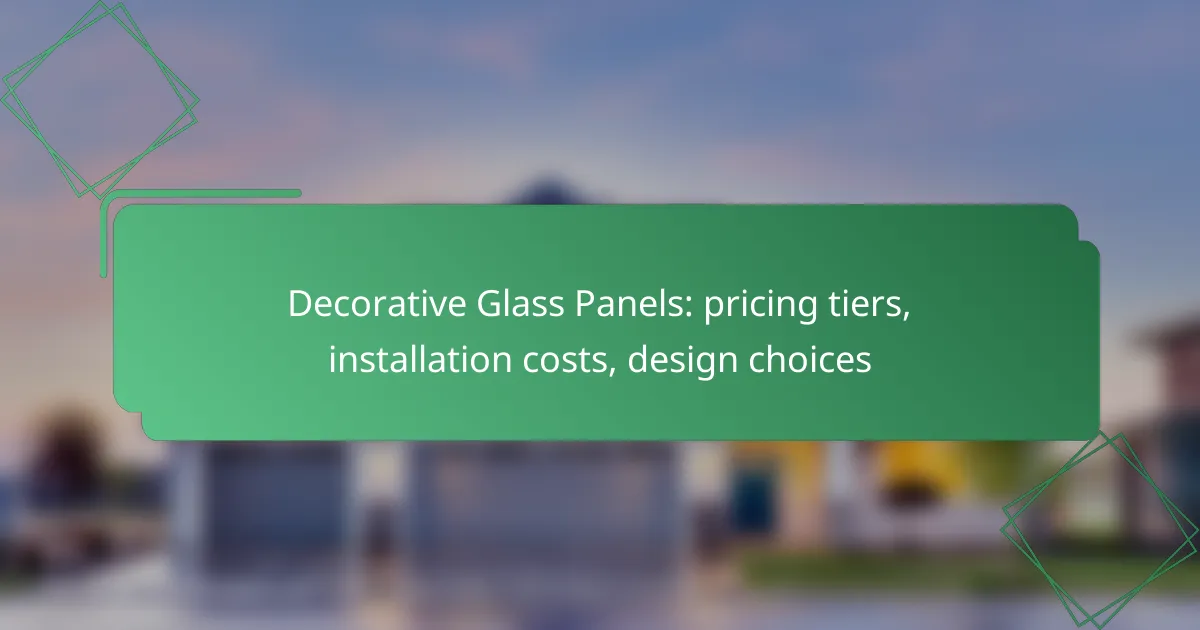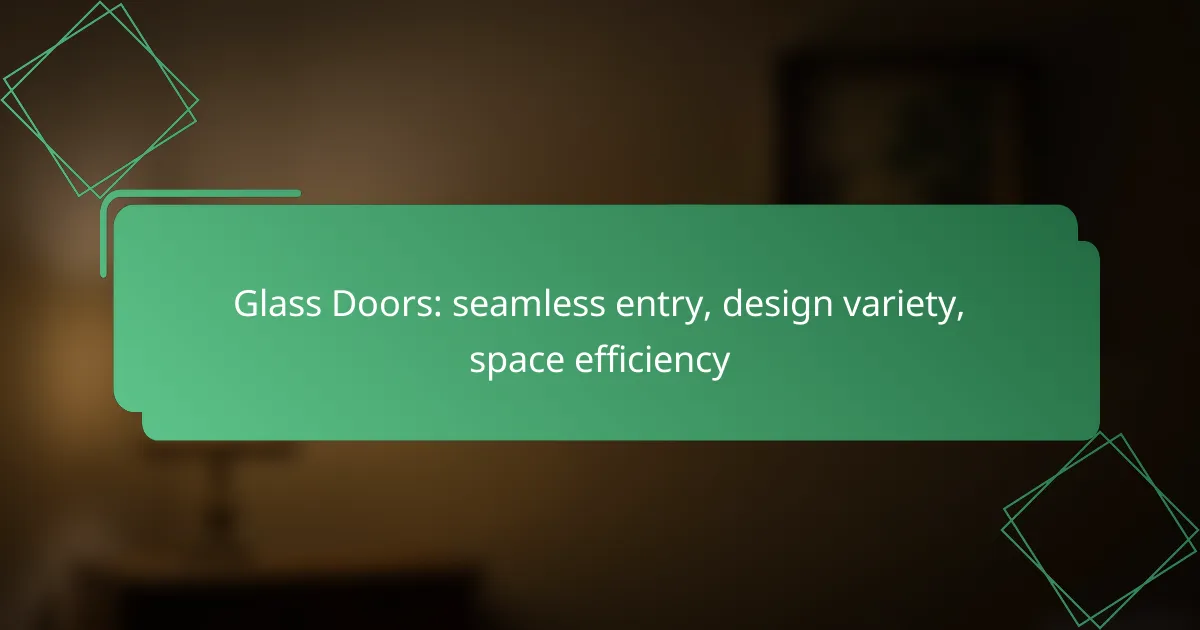Decorative glass panels provide an elegant touch to any space, with pricing tiers that cater to a range of budgets, from affordable to premium options. The overall cost is influenced by factors such as material quality, design intricacy, and installation methods, which can vary from DIY projects to professional services. With a wide array of design choices, including etched, frosted, and colored glass, homeowners and businesses can achieve a personalized aesthetic that enhances their environment.

What are the pricing tiers for decorative glass panels in Canada?
In Canada, decorative glass panels are available in various pricing tiers that typically range from affordable to premium options. The cost varies based on factors such as material, design complexity, and installation requirements.
Standard pricing for clear glass panels
Standard clear glass panels generally fall within the lower pricing tier, with costs typically ranging from CAD 50 to CAD 150 per panel. These panels are often used for basic applications, such as shower enclosures or room dividers, where clarity and simplicity are desired.
Installation costs for standard clear glass panels can add an additional CAD 100 to CAD 300, depending on the complexity of the installation and the labor rates in your area.
Premium pricing for etched glass panels
Etched glass panels are considered premium options, with prices usually starting around CAD 150 and going up to CAD 400 or more per panel. The unique designs and textures created through the etching process contribute to their higher cost, making them suitable for decorative applications in homes and businesses.
Installation of etched glass panels may also be more expensive, with labor costs potentially reaching CAD 200 to CAD 500, depending on the intricacy of the design and the installation site.
Cost factors influencing decorative glass pricing
Several factors influence the pricing of decorative glass panels, including material quality, thickness, and design complexity. Higher quality glass and thicker panels typically command higher prices due to their durability and aesthetic appeal.
Additionally, custom designs or intricate patterns can significantly increase costs. Labor rates for installation can vary based on location and the skill level required, further impacting the overall price.
Comparative pricing for custom designs
Custom decorative glass designs can vary widely in price, often ranging from CAD 200 to CAD 800 per panel. The final cost depends on the design’s complexity, the materials used, and the specific requirements of the project.
When considering custom designs, it’s essential to obtain quotes from multiple suppliers and installers to ensure competitive pricing and to evaluate the quality of craftsmanship offered.

What are the installation costs for decorative glass panels?
The installation costs for decorative glass panels can vary significantly based on factors such as location, design complexity, and whether the installation is DIY or professional. Generally, homeowners can expect to pay anywhere from a few hundred to several thousand Canadian dollars for installation, depending on these variables.
Average installation costs in Canadian cities
In major Canadian cities, the average installation costs for decorative glass panels typically range from CAD 500 to CAD 2,500. For instance, in Toronto, prices may lean towards the higher end due to labor costs, while smaller cities like Halifax might offer more affordable rates. It’s advisable to obtain multiple quotes to find the best price in your area.
Factors affecting installation pricing
Labor costs also vary by region and can significantly impact the total price. Areas with higher living costs typically have higher labor rates, so it’s essential to consider local market conditions when budgeting for installation.
DIY vs. professional installation costs

What design choices are available for decorative glass panels?
Decorative glass panels offer a variety of design choices that can enhance both residential and commercial spaces. Options range from etched and frosted glass to colored and patterned designs, allowing for personalization and aesthetic appeal.
Popular design styles for residential use
In residential settings, popular design styles include traditional, modern, and rustic themes. Traditional designs often feature intricate patterns or stained glass, while modern styles lean towards minimalism with clear or frosted panels. Rustic designs may incorporate natural textures or earthy colors to complement a cozy atmosphere.
Homeowners frequently choose glass panels for entryways, room dividers, or shower enclosures. Each application can significantly influence the overall ambiance of the space, making careful selection essential.
Trends in commercial decorative glass designs
Commercial decorative glass designs are increasingly focused on functionality and branding. Businesses often opt for large-scale installations that feature company logos or thematic elements that reflect their brand identity. This trend enhances customer experience while promoting brand recognition.
Another trend is the use of smart glass technology, which allows for adjustable opacity and energy efficiency. This innovation is particularly appealing in office environments where privacy and natural light are priorities.
Customization options for decorative glass panels
Customization options for decorative glass panels are extensive, allowing for unique designs tailored to specific needs. Homeowners and businesses can choose from various thicknesses, colors, and finishes, ensuring that the glass fits seamlessly into their design scheme.
Engraving, sandblasting, and digital printing are popular methods for creating custom patterns or images on glass. When considering customization, it’s important to balance aesthetic desires with budget constraints, as more intricate designs can increase costs significantly.

What are the prerequisites for installing decorative glass panels?
Installing decorative glass panels requires careful planning and specific conditions to ensure a successful outcome. Key prerequisites include adequate space, the right tools, and a solid understanding of the installation process.
Space requirements for installation
Before installing decorative glass panels, ensure that the installation area is free from obstructions and has sufficient space for maneuvering. Ideally, the space should allow for at least a few feet of clearance around the installation site to facilitate handling and positioning of the panels.
Additionally, consider the weight and dimensions of the glass panels. Larger panels may require more extensive support structures, so check that the walls or frames can accommodate the weight without compromising stability.
Necessary tools for installation
To install decorative glass panels, you will need several essential tools. Commonly required tools include a glass cutter, measuring tape, level, and safety gear such as gloves and goggles. A suction cup lifter can also be beneficial for handling larger panels safely.
Gathering these tools in advance can streamline the installation process. Ensure that all tools are in good working condition to avoid delays or accidents during installation. If you are unsure about using any tools, consider consulting a professional or reviewing instructional materials beforehand.

How to choose the right decorative glass panel?
Choosing the right decorative glass panel involves considering the intended use, design preferences, and budget. Assessing these factors will help you select a panel that enhances your space while meeting functional requirements.
Factors to consider for residential projects
For residential projects, aesthetics and functionality are paramount. Consider the room’s style and the panel’s design, such as etched, frosted, or colored glass, to ensure it complements your decor. Additionally, think about the panel’s durability and maintenance needs, as some finishes may require more upkeep than others.
Budget is another crucial factor. Decorative glass panels can range from affordable options in the low hundreds of USD to high-end custom designs that may cost thousands. It’s wise to balance your design aspirations with your financial constraints.
Key considerations for commercial applications
In commercial settings, durability and safety standards take precedence. Ensure the decorative glass panels meet local building codes and are suitable for high-traffic areas. Laminated or tempered glass options are often recommended for their strength and safety features.
Design flexibility is also important in commercial applications. Consider how the glass panels will enhance branding or create a specific atmosphere. Custom designs may be necessary, but they can significantly increase costs, so weigh the benefits against your budget.

What are the maintenance tips for decorative glass panels?
To maintain decorative glass panels, regular cleaning and careful handling are essential. Proper care not only enhances their appearance but also extends their lifespan.
Cleaning methods for longevity
For effective cleaning, use a soft microfiber cloth and a gentle glass cleaner to avoid scratching the surface. Avoid abrasive materials that can damage the finish of the decorative glass.
It’s best to clean glass panels regularly, ideally every few weeks, to prevent the buildup of dust and grime. In areas with high humidity or exposure to the elements, consider more frequent cleaning to maintain clarity.
When cleaning, work in sections and dry the glass immediately to prevent water spots. For stubborn stains, a mixture of vinegar and water can be effective, but always test on a small area first to ensure it does not harm the finish.










